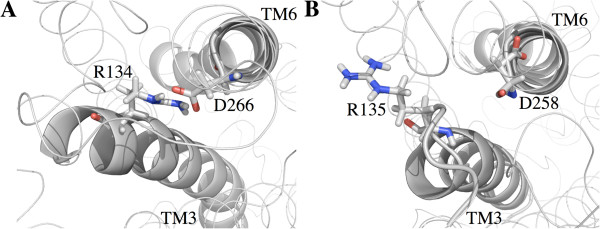Figure 7.

Orientation of the arginine in gsctt is not correct for salt bridge formation. Intracellular views of TM3 and TM6 are shown. The arginine and aspartic acid residues studied for formation of a salt bridge are shown as sticks, with the nitrogen atoms labeled blue and the oxygen atoms labeled red. TM3 and TM6 helices are represented as gray ribbons. (A) The gtre1 model system at 270 ns. In gtre1, R134 and D266 are close enough to form a salt bridge. Nitrogen – oxygen distances range from 2.4 – 4.9 Å. (B) The gsctt model system at 276 ns. The nitrogen atoms of R135 and the oxygen atoms of D266 are not facing each other, which prevents a salt bridge from forming between these residues. Nitrogen – oxygen distances range from 10.3 – 14.8 Å.
